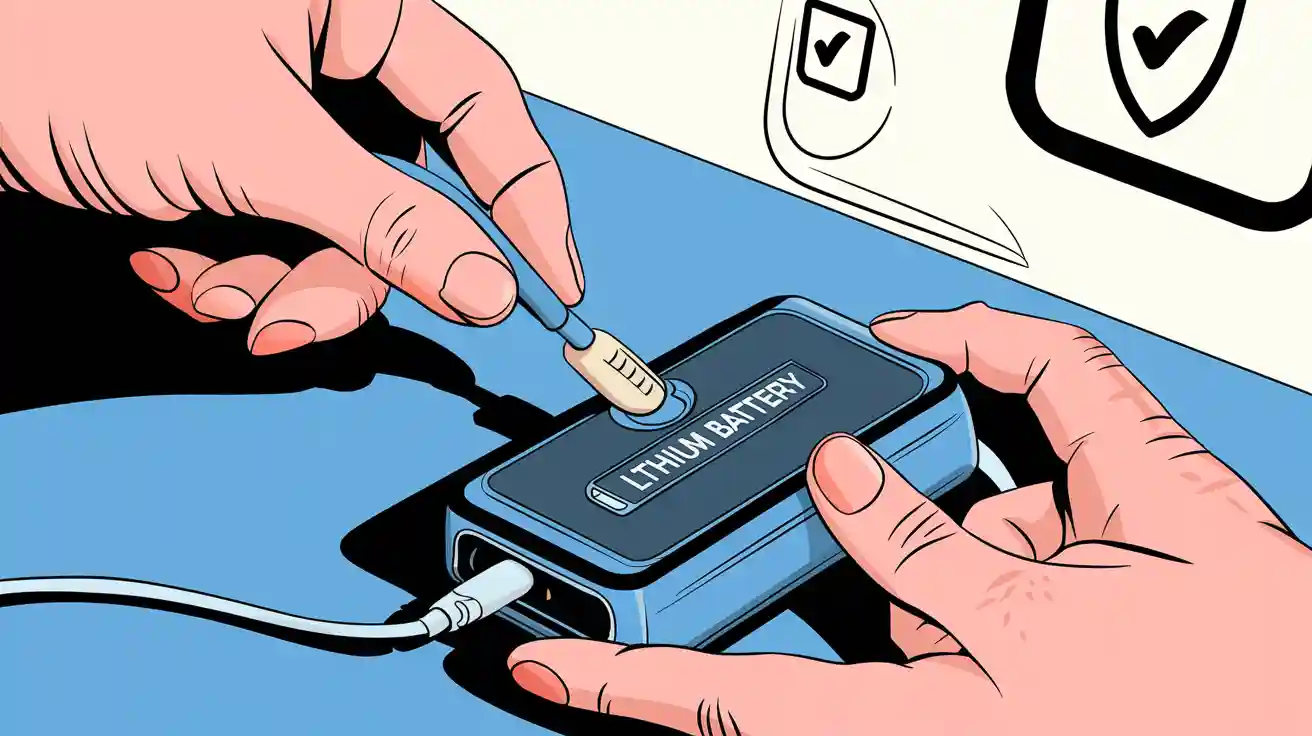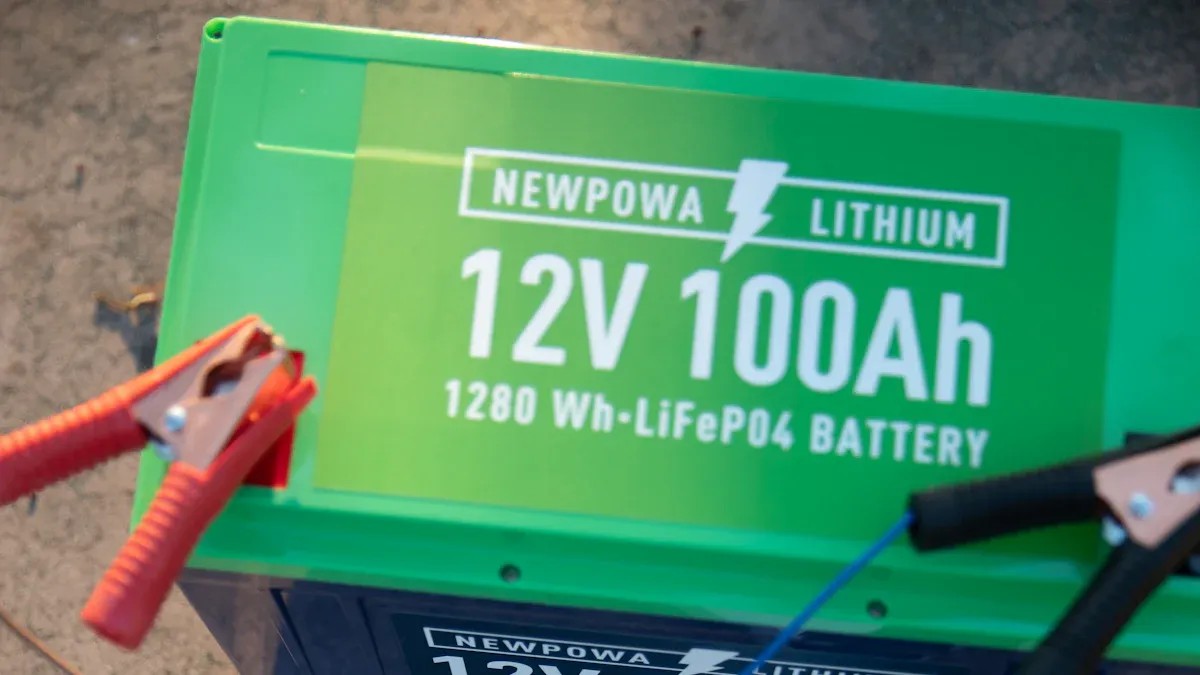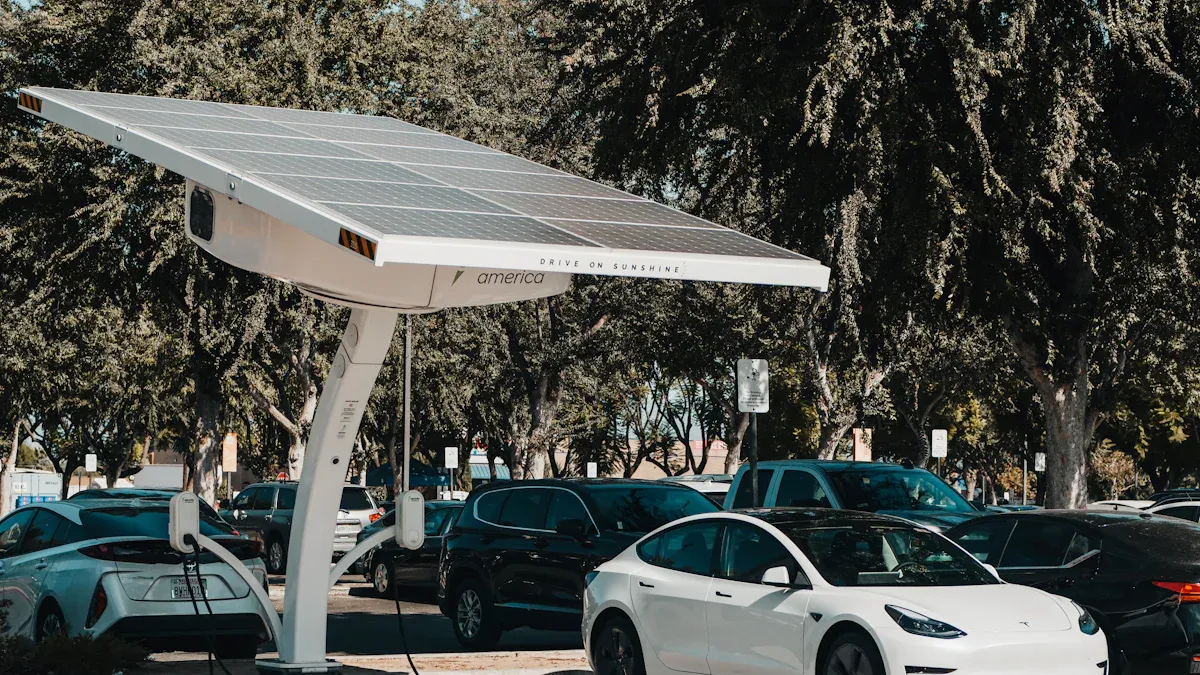
You cannot use just any charger for lithium batteries. Always match the charger type and voltage to your lithium battery pack. Using the wrong charger leads to risks like:
Overheating, fire hazards, and explosions
Permanent battery damage or failure
Overcharge events that shorten battery lifespan
Charging rechargeable batteries or lithium-ion batteries safely means you must verify compatibility before charging. Charging NiCd batteries safely requires different protocols.
Key Takeaways
Always use a charger designed for your lithium battery type and match the voltage exactly to avoid risks like overheating, fire, or battery damage.
Follow safe charging steps: charge in a well-ventilated area, monitor temperature and voltage, and never leave batteries unattended while charging.
Check batteries for damage before charging and stop immediately if you notice swelling, heat, or strange smells to protect yourself and extend battery life.
Part 1: Charger and Voltage

1.1 Battery Chemistries
You must understand the differences between battery chemistries before selecting a charger. Lithium batteries, including LiFePO4, NMC, LCO, LMO, and LTO, each have unique platform voltages, energy densities, and cycle lives. The table below compares these lithium chemistries:
Chemistry | Platform Voltage (V) | Energy Density (Wh/kg) | Cycle Life (cycles) |
|---|---|---|---|
LiFePO4 | 3.2 | 90-120 | 2000+ |
NMC | 3.7 | 150-220 | 1000-2000 |
LCO | 3.7 | 150-200 | 500-1000 |
LMO | 4.0 | 100-150 | 300-700 |
LTO | 2.4 | 70-80 | 7000+ |
Lithium batteries require specialized charging techniques. You cannot use NiCd or NiMH chargers for lithium-ion batteries. Charging rechargeable batteries with the wrong charger can cause battery failure or hazards. Lithium batteries need strict voltage and current control, while NiCd and NiMH batteries tolerate deeper discharge and overcharge.
1.2 Charging NiCd Batteries Safely
Charging nicd batteries safely means using a charger designed for NiCd chemistry. NiCd batteries use constant current charging, allowing voltage to rise freely. Full charge detection relies on a slight voltage drop (negative delta V) or a temperature increase. You can use higher charge rates for NiCd batteries, and ultra-fast charging is possible with minimal stress. Charging nicd batteries safely requires monitoring voltage and temperature to avoid overcharge. Never use a lithium charger for NiCd batteries or vice versa.
Tip: Always check the battery label and charger specifications before charging rechargeable batteries. Using the wrong charger can damage the battery and create safety risks.
1.3 Voltage Risks
Using a charger with incorrect voltage for lithium batteries can cause severe hazards. High voltage or short circuits may lead to excess heat, fire, or even explosions. Lithium-ion batteries require precise voltage control, typically charging up to 4.2V per cell for LCO or 3.6V per cell for LiFePO4. You must match the charger cell count to the battery label and inspect batteries for damage before charging. Full charge detection for lithium batteries depends on voltage thresholds and current tapering, not temperature rise. Always charge in fireproof locations and never leave charging batteries unattended.
Part 2: Safe Charging Steps

2.1 Find the Right Charger
Selecting the correct charger for lithium battery packs is essential for safe and efficient charging. You must match the charger voltage and current to the battery specifications. Chargers designed for lithium chemistries—such as LiFePO4, NMC, LCO, LMO, and LTO—incorporate advanced charging techniques and safety features. These include temperature monitoring, overcharge protection, and current/voltage limits. High-quality chargers often feature a Current Interrupt Device (CID) that cuts off charging under unsafe conditions.
Criterion | Description |
|---|---|
Charger Voltage | Must match battery pack voltage; e.g., 4.2 V per cell for Li-ion, 3.65 V per cell for LiFePO4. |
Charging Current | Should be within 0.5C to 1C of battery capacity (up to 10C for fast charging LiFePO4 with caution). |
Charging Algorithm | Use CC-CV (Constant Current – Constant Voltage) tailored to battery chemistry. |
Safety Features | Overcharge protection, temperature monitoring, fault alarms, automatic cutoff at full charge. |
Chemistry Compatibility | Charger must be designed for the specific lithium chemistry to avoid damage. |
Smart Charger Recommendation | Use smart automatic chargers with built-in monitoring and cutoff to prevent overcharging and capacity loss. |
Voltage Limits | Charger must not exceed max voltage per cell to prevent swelling, overheating, or explosion. |
Charging Profile Support | Charger should support the battery’s specific charging profile to ensure longevity and safety. |
When choosing a charger for lithium battery packs in medical, robotics, security, infrastructure, consumer electronics, or industrial applications, always verify certifications such as UL 1642, UL 2054, IEC 62133, and CE Marking. These certifications ensure compliance with safety and quality standards.
Tip: Always use chargers recommended by the battery manufacturer. Using non-original chargers can void warranties and compromise safety.
2.2 Safe Charging Guide
Charging rechargeable batteries safely requires following a step-by-step process. You must ensure the charger is compatible with the lithium battery pack and can regulate voltage and current accurately. Begin by connecting the battery to the charger with correct polarity. Set the charger parameters according to the battery chemistry—typically 4.2V per cell for lithium-ion batteries and 3.65V per cell for LiFePO4.
Follow these steps for safe charging:
Prepare a well-ventilated area, away from combustible materials.
Maintain ambient temperature between 15°C and 35°C during charging.
Connect the battery and charger with correct polarity.
Start charging using the CC-CV protocol: constant current until maximum voltage, then constant voltage with decreasing current.
Monitor voltage, current, and temperature using a battery management system (BMS) or precision tools.
Watch for signs of overheating, swelling, or unusual behavior.
After charging, switch off the charger, disconnect carefully, and inspect the battery for damage.
Store batteries in a cool, dry place. For long-term storage, keep the battery partially charged (~50%).
Charger Type | Features & Use Case | Portability | Charging Capacity | Additional Functionalities |
|---|---|---|---|---|
Wall Chargers | Plug into wall outlets, can charge multiple batteries simultaneously | Low (not portable) | Multiple batteries | Simple use, no advanced features |
Car Chargers | Designed for vehicle cigarette lighter socket, useful on the go | High (compact) | Usually one battery at a time | Basic charging, limited capacity |
USB Chargers | Plug into USB ports, ideal for travel, slower charging | High (portable) | Multiple batteries (varies) | Slower charging, convenient for travel |
Multi-function Chargers | Support multiple battery types, offer fast charging, battery analysis, safety protections | Medium to High | Multiple batteries | Advanced features: fast charge, battery testing, repair |
You should always monitor the charging process using charger indicators or displays. Disconnect the charger promptly after full charge detection to avoid unnecessary trickle charging.
2.3 Safety Considerations
Safety considerations are critical when charging lithium battery packs. You must use chargers specifically designed for lithium chemistries and adhere to recommended charging parameters. Overheating, thermal runaway, fire hazards, and battery deformation are common risks. These often result from incompatible chargers, exceeding recommended charging current, physical damage, or exposure to high temperatures.
Condition | Temperature Range | Humidity Recommendation | Additional Notes |
|---|---|---|---|
Charging | 0°C to 45°C (32°F-113°F) | Below 60% | Gradual warming before charging in cold conditions |
Storage | 10°C to 25°C (50°F-77°F) | 40-60% (optimal SOC) | Avoid temperatures above 30°C or below -20°C |
Operating (general) | -20°C to 60°C (-4°F-140°F) | N/A | Extreme cold reduces ion mobility; heat accelerates degradation |
You should inspect batteries for damage before charging. If you notice swelling, overheating, or unusual smells, discontinue charging immediately. Use chargers with built-in temperature control, overcharge protection, and automatic cutoff at full charge. Never leave batteries charging unattended, especially in high-risk environments like industrial or infrastructure settings.
Note: Charging lithium batteries outside the recommended temperature range can void warranties and cause permanent damage.
2.4 Mistakes and Warnings
Many users make frequent mistakes when charging lithium battery packs. Physical damage, mixing batteries with different states of charge, bypassing the BMS, and overcharging are common errors. Charging at sub-zero temperatures without proper control, loose fasteners, and charging near flammable materials also increase risk.
Common warning signs of improper charging include:
Swelling or bulging: Visible lumps or leakage from the battery casing.
Unusual sounds: Hissing, cracking, or popping noises.
Odors: Strong or unusual smells.
Smoking: Indicates a fire may have started.
If you observe any of these signs, stop charging immediately, unplug the device, and move it away from flammable materials if safe. Seek professional help for battery replacement and disposal.
Alert: Never attempt to puncture or press a swollen battery. Always consult a professional for safe removal and disposal.
2.5 Alternative Methods
Alternative charging methods for lithium battery packs exist, but they have significant limitations compared to dedicated chargers. You may use a DC power supply, solar panel charging with a compatible controller, or car battery chargers if adjustable and compatible. However, these methods lack precise voltage and current control, safety features, and optimized charging profiles.
Manufacturer-recommended charging techniques emphasize using specified equipment, adhering to voltage and temperature limits, and employing a BMS. Charging below 0°C is generally prohibited unless the current is drastically reduced. Ultra-fast charging above 1C is discouraged due to increased degradation and safety risks.
Method | Advantages | Limitations |
|---|---|---|
DC Power Supply | Adjustable voltage/current | Requires manual control, risk of overcharging |
Solar Panel + Controller | Renewable energy, off-grid charging | Must use compatible controller, risk of voltage spikes |
Car Battery Charger | Convenient for field use | Often lacks lithium charging profile, risk of damage |
Dedicated Lithium Charger | Optimized charging, safety features | Higher cost, but ensures safety and longevity |
Callout: Always prioritize dedicated lithium chargers for medical, robotics, security, infrastructure, consumer electronics, and industrial applications. Alternative methods should only be used temporarily and with caution.
You protect your lithium battery investment by always using the manufacturer-recommended charger and matching voltage. Improper charging risks overheating, swelling, and reduced battery lifespan. Following best practices, such as monitoring full charge and using lithium-specific chargers, can extend battery life. See how charging protocols impact battery lifespan:
Number of Full Charging Cycles | Expected Battery Lifespan |
|---|---|
300 | Approximately 2-3 years |
1,000 | Approximately 3-5 years |
3,000 | Approximately 5-7 years |
10,000 | Approximately 8-10 years |
15,000 | Over 10 years |
Use lithium-specific chargers with intelligent charging logic.
Charge at slow rates to minimize heat.
Avoid charging above 80% capacity regularly.
Store batteries in cool, dry places.
Prioritize safety and battery longevity by following proper charging protocols for every lithium battery pack.
FAQ
What happens if you use the wrong charger for a lithium battery pack?
You risk overheating, fire, or permanent battery damage. Always use a charger designed for your battery chemistry and voltage to ensure safe charging.
How can you tell if a lithium battery is charging safely?
Monitor the battery temperature and look for swelling or unusual smells. Use a charger with safety features. Charging indicators should show normal progress without warning lights.
Can you use one charger for different lithium battery chemistries?
No. Each lithium battery chemistry requires a specific charging profile. Using the wrong charger can reduce battery lifespan or cause safety hazards. Always match the charger to the battery type.
Tip: Always check the battery label and charger specifications before charging. This step prevents costly mistakes and extends battery life.
Battery Chemistry | Recommended Charging Voltage (per cell) | Charging Profile Needed |
|---|---|---|
LiFePO4 | 3.65 V | CC-CV |
NMC, LCO, LMO | 4.2 V | CC-CV |
LTO | 2.8 V | CC-CV |




